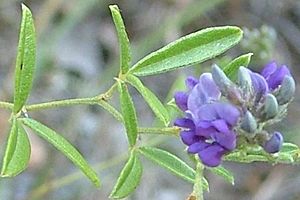Slimflower scurfpea facts for kids
Quick facts for kids Slimflower scurfpea |
|
|---|---|
 |
|
| Scientific classification | |
| Genus: |
Psoralidium
|
| Species: |
tenuiflorum
|
| Synonyms | |
|
|
The slimflower scurfpea, also known as Psoralidium tenuiflorum, is a cool plant in the pea family. It grows about 2 to 3 feet (60 to 90 cm) tall. This plant has many leaves, and each leaf can be up to 3 inches (7.6 cm) long. You can find the slimflower scurfpea mostly in the central and southwestern parts of the United States.
A German-American scientist named Frederick Traugott Pursh first described this plant. He called it Psoralea tenuiflora. Later, an American botanist, Per Axel Rydberg, moved it to a different group, the Psoralidium genus. That's how it got its current main name, Psoralidium tenuiflorum.
Contents
Where Does the Slimflower Scurfpea Grow?
This plant is very tough and likes dry, sandy places. It grows well in areas like semi-deserts, scrublands, and woodlands. The slimflower scurfpea has a long root that goes deep into the ground. This special root helps it survive when there isn't much rain.
What Does the Slimflower Scurfpea Look Like?
The slimflower scurfpea is a plant that comes back every year. It has many branches and can grow up to 3 feet (90 cm) tall. Its thin stems are a grayish-green color. The leaves are made up of smaller leaflets, usually three, or sometimes four to five.
Small groups of purplish, pea-like flowers grow along the stems. After the flowers bloom, they turn into short, round pods. Each pod holds just one seed.
Where Can You Find This Plant?
You can find the slimflower scurfpea in many central and southwestern U.S. states. These include Arizona, Colorado, Iowa, Illinois, Indiana, Kansas, Kentucky, Minnesota, Missouri, Montana, North Dakota, Nebraska, New Mexico, Oklahoma, South Dakota, Texas, Utah, Wisconsin, and Wyoming.
How Does the Slimflower Scurfpea Interact with Nature?
The flowers of the slimflower scurfpea are very popular with bees! Different types of bees, like Svastra obliqua, Colletes willistoni, and Calliopsis andreniformis, visit the plant.
Other insects also like this plant. Leaf beetles, such as Luperosoma parallelum, eat its leaves. Grasshoppers like Melanoplus femurrubrum, Melanoplus foedus, and Melanoplus packardii also feed on the leaves. Even the larvae (young ones) of a moth called Schinia jaguarina eat the plant's seed pods.
What Are the Uses of the Slimflower Scurfpea?
People have used the slimflower scurfpea for many things over a long time. For example, you can eat its root, either raw or cooked. The root can also be ground into a powder to make soups thicker or mixed with grains to bake bread.
This plant can also be an ingredient in a special drink made from the Agave plant. In traditional medicine, people used it to help with headaches, the flu, and even tuberculosis. They would make a drink from the roots or smoke the leaves for these treatments.
The stems of the plant can be woven into a garland. This garland can be used like a sun hat on hot days. The stems have also been burned to create smoke that helps keep mosquitoes away. The Zuni people used the moistened leaves as a poultice (a soft, moist mass) on their bodies for purification.

